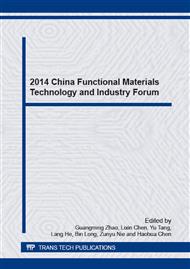p.550
p.554
p.563
p.569
p.573
p.578
p.583
p.589
p.596
Preparation and Properties Characterization of N-Doped TiO2 Film
Abstract:
Nitrogen-doped nanoTiO2 sol was prepared by sol-gel method. The obtained sol was coated onto glass substrates by spin coating method, followed by drying at low temperature and calcined at high temperature. The films were characterized by X-ray diffraction (XRD), scanning electron microscope (SEM) and ultraviolet-visible spectra (UV-Vis) . The XRD spectra showed that the crystal type of N-doped TiO2 films was anatase. The SEM images showed that the surface of films were flat without obvious crack and average diameter was about 20 nm. The UV-Vis spectra showed that the absorbance of N-doped TiO2 films at ultraviolet region increased. N-doping caused photocatalysis response wavelength to turn longer. The photocatalytic activity of N-doped TiO2 films was researched through the degradation experiment of methyl orange under ultraviolet light. Higher photocatalytic degradation efficiency was exhibited compared to the pure TiO2 films.
Info:
Periodical:
Pages:
573-577
Citation:
Online since:
December 2014
Authors:
Keywords:
Price:
Сopyright:
© 2015 Trans Tech Publications Ltd. All Rights Reserved
Share:
Citation:


